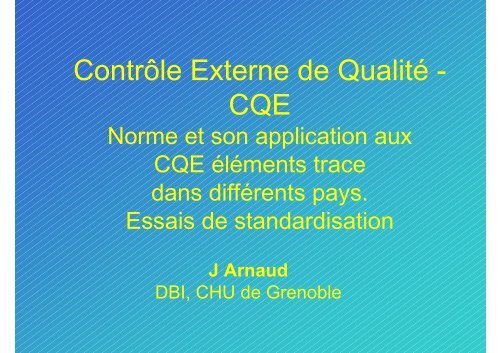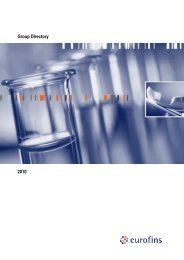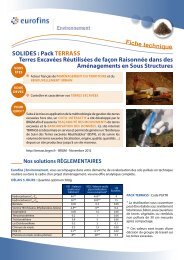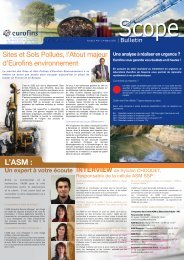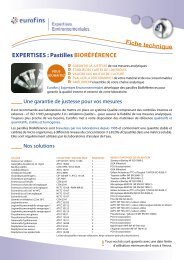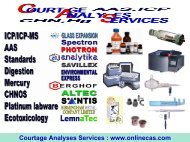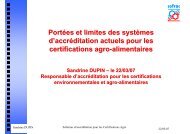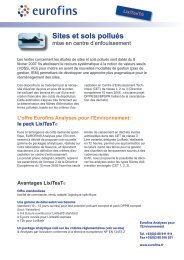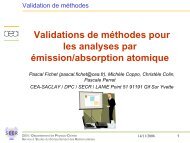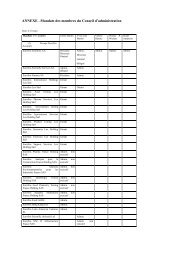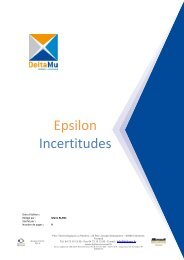Contrôle Externe de Qualité - CQE - Eurofins
Contrôle Externe de Qualité - CQE - Eurofins
Contrôle Externe de Qualité - CQE - Eurofins
You also want an ePaper? Increase the reach of your titles
YUMPU automatically turns print PDFs into web optimized ePapers that Google loves.
<strong>Contrôle</strong> <strong>Externe</strong> <strong>de</strong> <strong>Qualité</strong> -<br />
<strong>CQE</strong><br />
Norme et son application aux<br />
<strong>CQE</strong> éléments trace<br />
dans différents pays.<br />
Essais <strong>de</strong> standardisation<br />
J Arnaud<br />
DBI, CHU <strong>de</strong> Grenoble
<strong>CQE</strong> et assurance qualité<br />
Métho<strong>de</strong>s analytiques validées<br />
(précision, exactitu<strong>de</strong>, domaine <strong>de</strong> mesure)<br />
Echantillon à valeur certifiée<br />
(calibrage, détermination valeur cible <strong>de</strong>s CQI « maison »)<br />
<strong>Contrôle</strong> <strong>de</strong> qualité interne = CQI<br />
(validation technique <strong>de</strong>s résultats au quotidien)<br />
<strong>CQE</strong><br />
(stabilité <strong>de</strong>s performances, efficience du CQI<br />
dans les conditions réelles d’utilisation)<br />
Normes<br />
ISO Gui<strong>de</strong> 43<br />
ISO/DIS 13528:2003 (E)
Objectif <strong>de</strong>s <strong>CQE</strong><br />
Permettre aux laboratoires<br />
d’obtenir une qualité constante <strong>de</strong> résultats<br />
dans <strong>de</strong>s conditions d’utilisation <strong>de</strong> routine<br />
et <strong>de</strong> vérifier la validité <strong>de</strong>s procédures
Mise en œuvre <strong>de</strong>s <strong>CQE</strong><br />
1-Envoi d’échantillons<br />
3-Analyse statistique<br />
Rendu <strong>de</strong>s résultats<br />
Organisateur<br />
Planning<br />
Participants<br />
Comité <strong>de</strong> suivi<br />
2-Analyse<br />
Envoi <strong>de</strong>s résultats<br />
4- Evaluation
Rôles et <strong>de</strong>voirs <strong>de</strong> l’Organisateur<br />
Description <strong>de</strong>s protocoles utilisés<br />
(préparation, expédition, analyse, statistiques, interprétation,<br />
information, confi<strong>de</strong>ntialité)<br />
Envois <strong>de</strong>s échantillons et rédaction <strong>de</strong>s rapports<br />
6 envois (3 à 26) annuels - 3 échantillons / envoi (1 à 5)<br />
performances individuelle et collective<br />
Information <strong>de</strong>s participants<br />
sur le <strong>CQE</strong><br />
dysfonctionnement<br />
modification<br />
Confi<strong>de</strong>ntialité<br />
Amélioration continue<br />
Comité <strong>de</strong> suivi<br />
Consultant (participants ayant performances inadéquates)
Rôle et <strong>de</strong>voirs du participant<br />
Analyse <strong>de</strong>s échantillons<br />
(comme <strong>de</strong>s échantillons <strong>de</strong> routine)<br />
Envoi résultats<br />
(métho<strong>de</strong>)<br />
Évaluation<br />
(actions correctives)<br />
Signalement<br />
<strong>de</strong> toute anomalie et dysfonctionnement<br />
modification<br />
Déontologie<br />
Ne jamais communiquer son rang et son co<strong>de</strong><br />
seulement ses performances
Préparation échantillon<br />
Matrice<br />
Concentration<br />
Homogénéité<br />
Stabilité (≥ pério<strong>de</strong> <strong>de</strong> validité)
Valeur cible<br />
Déterminée avant ou après l’envoi<br />
inconnu <strong>de</strong>s participants jusqu’aux résultats<br />
laboratoire <strong>de</strong> référence + métho<strong>de</strong> <strong>de</strong> référence<br />
envoi d’échantillon à valeur certifiée<br />
formulation (maîtrise <strong>de</strong> tous les composants)<br />
comparaison directe à échantillon à valeur certifié<br />
(métho<strong>de</strong> <strong>de</strong> référence, matrices i<strong>de</strong>ntiques)<br />
valeur consensuelle d’un groupe d’experts<br />
valeur consensuelle <strong>de</strong>s participants<br />
nombre participants >15<br />
métho<strong>de</strong>s vali<strong>de</strong>s<br />
élimination <strong>de</strong>s valeurs déviantes<br />
médiane, moyenne robuste<br />
le plus<br />
utilisé
Incertitu<strong>de</strong><br />
Dépendante ou non <strong>de</strong> l’échantillon<br />
écart-type <strong>de</strong>s participants<br />
(élimination valeurs aberrantes)<br />
écart-type <strong>de</strong> laboratoires experts<br />
valeur définie par la législation<br />
critère <strong>de</strong> qualité = QS<br />
ou limites externes ou limites maximales admissibles
8,00<br />
7,00<br />
6,00<br />
5,00<br />
4,00<br />
3,00<br />
2,00<br />
1,00<br />
0,00<br />
Proposed Limit_05<br />
Outer proposed limits: Cu or Zn<br />
Limit Zn NY y = 0,15x<br />
Limit Cu NY : y = 0,1x<br />
Limit IT : y = 0,075x + 0,6<br />
Limit CA, FR : y = 0,08x + 0,4<br />
Limit BE, UK : y = 0,031x + 0,9<br />
Concentration, µmol/l<br />
0 10 20 30 40 50 60
QS, µmol/l<br />
0,90<br />
0,80<br />
0,70<br />
0,60<br />
0,50<br />
0,40<br />
0,30<br />
Outer limits proposed for Se<br />
Limit NY : y = 0,2x<br />
Proposed limit<br />
Limit BE, CA, FR, UK : y = 0,064x + 0,072<br />
0,20<br />
0,10<br />
Limit IT : y = 0,060x + 0,057<br />
0,00<br />
Concentration, µmol/l<br />
0,00 1,00 2,00 3,00 4,00 5,00
Quality specifications used for<br />
performance assessment z-scores<br />
Assay Quality specification<br />
Blood Pb ± 10% at concentrations > 1.5 µmol/L<br />
Serum Al ± 20% at concentrations > 0.9 µmol/L<br />
Serum Cu ± 15% at concentrations > 10 μmol/L<br />
Serum Se ± 15% at concentrations > 0.7 μmol/L<br />
Serum Zn ± 15% at concentrations > 10 μmol/L
Rapport à chaque envoi<br />
Agenda:<br />
- le plus prêt possible <strong>de</strong> la date limite <strong>de</strong> rendu<br />
- avant l’envoi suivant<br />
Contenu = Résultats individuels et collectifs<br />
valeurs individuelles<br />
z-score = valeur x – valeur cible<br />
QS/2 ou QS/3<br />
ou limite interne<br />
Respect <strong>de</strong> l’anonymat<br />
graphes<br />
statistiques<br />
global,<br />
par métho<strong>de</strong>
Moy.<br />
Dév. Std<br />
Nombre<br />
Maximum<br />
Coef. Var.<br />
Médiane<br />
Moy.<br />
Dév. Std<br />
Nombre<br />
Coef. Var.<br />
Médiane<br />
Cu<br />
Cu<br />
Interquartile<br />
Rapport à chaque envoi<br />
11,808<br />
,824<br />
36<br />
13,700<br />
,070<br />
11,775<br />
9,898<br />
,679<br />
35<br />
,069<br />
9,900<br />
,635<br />
Nombre<br />
14<br />
12<br />
10<br />
8<br />
6<br />
4<br />
2<br />
0<br />
Nombre<br />
9 9,5 10 10,5 11 11,5 12 12,5 13 13,5 14 14,5<br />
10<br />
9<br />
8<br />
7<br />
6<br />
5<br />
4<br />
3<br />
2<br />
1<br />
Cu µmol/l<br />
0<br />
8,0 8,5 9,0 9,5 10,0 10,5 11,0 11,5 12,0<br />
Cu, µmol/l<br />
Z-score<br />
2,5<br />
1,5<br />
-,5<br />
-1<br />
-1,5<br />
-2<br />
-2,5<br />
Z-score Cu<br />
2<br />
1<br />
,5<br />
0<br />
3<br />
2<br />
1<br />
0<br />
-1<br />
-2<br />
0 25 50 75 100<br />
Centiles<br />
0 25 50 75 100<br />
Centiles
4<br />
3<br />
2<br />
1<br />
0<br />
-1<br />
-2<br />
-3<br />
-4<br />
Rapport « annuel »<br />
Graphes <strong>de</strong> l’évolution individuelle <strong>de</strong>s résultats<br />
Ecart à la valeur cible<br />
Écart, µmol/l<br />
inadéquat<br />
acceptable<br />
excellent<br />
Cible, µmol/l<br />
0 10 20 30 40<br />
excellent<br />
acceptable<br />
inadéquat
4<br />
2<br />
0<br />
-2<br />
-4<br />
Rapport « annuel »<br />
Graphes <strong>de</strong> l’évolution individuelle <strong>de</strong>s résultats<br />
Z-score au cours du temps<br />
Z-score = [valeur observée - valeur cible] / [QS/2]<br />
0 3 6 9 12 15 18
Rapport « annuel »<br />
Scores <strong>de</strong> reproductibilité (facultatif)<br />
Taux <strong>de</strong> participation<br />
Pas <strong>de</strong> classement<br />
Respect <strong>de</strong> l’anonymat<br />
Mettre un commentaire si z-score hors <strong>de</strong> ± 2
Causes d’un Z-score > ± 2<br />
1-CQI défectueux<br />
Matrice<br />
Concentration<br />
Fabrication<br />
Reconstitution<br />
Utilisation <strong>de</strong>s résultats<br />
Valeur cible<br />
3-Métho<strong>de</strong><br />
défectueuse<br />
2-<strong>CQE</strong> défectueux<br />
Préparation<br />
Interférence<br />
Valeur cible
Diagramme décisionnel<br />
Z-score > ± 2<br />
Vérification <strong>de</strong>s traces du dosage<br />
(blancs, calibrage, CQI, ajouts…)<br />
n<br />
OK? Cause trouvée<br />
o<br />
Repassage<br />
OK?<br />
o<br />
n<br />
Évènement ponctuel<br />
cause inconnue<br />
Analyse <strong>CQE</strong> + échantillon certifié<br />
Échantillon<br />
certifié OK?<br />
o<br />
<strong>CQE</strong> défectueux<br />
n<br />
CQI défectueux<br />
Métho<strong>de</strong> à vérifier
Diagramme décisionnel<br />
Valeur cible<br />
Enquête approfondie<br />
<strong>CQE</strong> défectueux<br />
Avertir l’organisateur<br />
Interférence<br />
Décision
Diagramme décisionnel<br />
CQI défectueux<br />
Métho<strong>de</strong> à vérifier<br />
Analyse CQI + échantillon certifié<br />
Échantillon<br />
certifié OK?<br />
o<br />
CQI défectueux<br />
n<br />
Métho<strong>de</strong> à vérifier<br />
Cas particulier<br />
Analyse multi-élémentaire<br />
n<br />
Un élément<br />
affecté?<br />
Préparation échantillon<br />
Réglage appareil<br />
o<br />
Calibrage
Références<br />
- Thompson M, Ellison SLR, Wood R. The international<br />
harmonized protocol for the proficiency testing of analytical<br />
chemistry laboratories (IUPAC Technical Report) – 2005<br />
- Statistical methods for use in proficiency testing by<br />
interlaboratory comparisons ISO/FDIS 13528 – 2005<br />
- Use of external quality assessment schemes in the assessment<br />
of the performance of in vitro diagnostic examination<br />
procedures – European standard - 2003<br />
-Quality of proficiency testing schemes in testing state of<br />
practice in Europe in terms of ISO gui<strong>de</strong> 43 – 2000<br />
- Taylor A et al. Comparison of procedures for evaluating<br />
laboratory performances in external quality assessment<br />
schemes for lead in blood and aluminium in serum<br />
<strong>de</strong>monstrates the need for common quality specifications. Clin<br />
Chem 2002, 48, 2000-2007


